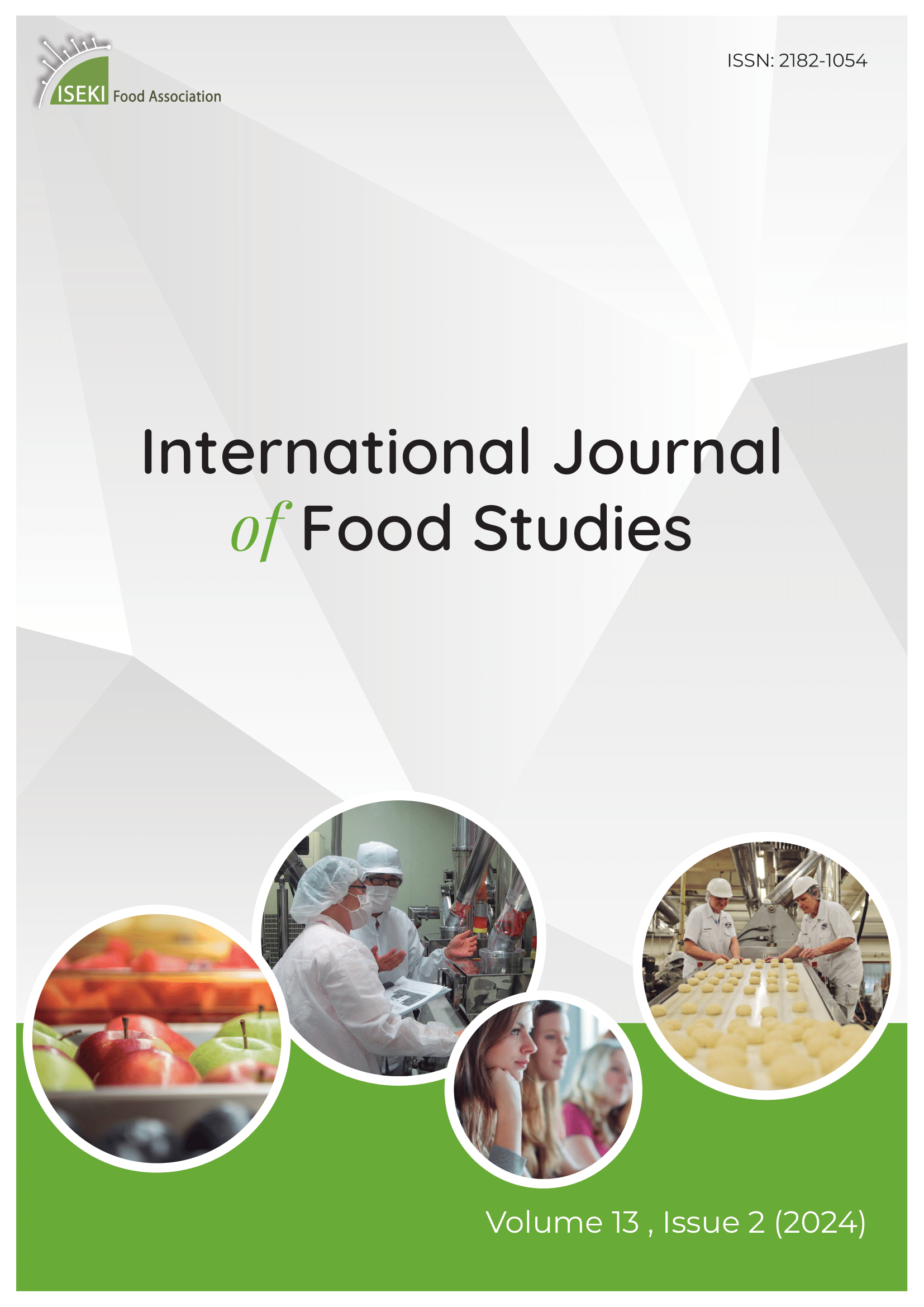Contents
01.12.2017.
Professional paper
Quality assessment and shelf life modeling of pulsed electric field pretreated osmodehydrofrozen kiwifruit slices
The objective of this workwas to investigate the potential use of pulsed electric field (PEF) in combination with osmotic dehydration (OD) as a pre-freezing step and to evaluate the effect on quality characteristics and shelf life of frozen kiwifruit. Peeled kiwifruit was subjected to PEF (1.8 kV/cm), sliced and treated in OD-solution [containing glycerol, maltodextrin, trehalose, ascorbic acid, calcium chloride, citric acid, sodium chloride; 1/5 (wfruit/wsolution)] for 30 and 60 min at 35 °C. Combined, PEF only and OD only treated samples as well as nontreated and blanched (80 °C, 60 s) samples were frozen and stored at constant (-5, -10, -15, -25 °C) and dynamic temperature conditions (-18 °C-3 d, -8 °C-2.5 d, -15 °C-3 d). Quality of frozen samples was evaluated by means of drip loss, colour, texture, vitamin C and sensory evaluation (1-9 scale); and shelf life (SL) was calculated. Nontreated and blanched samples presented high drip loss and tissue softening (instrumentally measured as Fmax decrease). The tissue integrity was well retained in all osmotically pretreated samples. PEF pretreatment caused increase of fruit whiteness (increase of L value) and yellowness (a and/or b value increase); SL calculation was based on colour change. All OD samples had high vitamin content (24.6 mg/100 g fresh material compared to 138-154 mg/100 g osmodehydrated material); PEF led to 93% (of the initial) vitamin retention; blanched samples showed the lowest retention (86.9% of the initial) (criteria for SL calculation). OD and combined PEF-OD treatment increased the shelf life of frozen kiwifruit (up to 3 times; based on sensorial criteria). The developed kinetic models for colour change, vitamin loss, and sensory quality deterioration were validated at dynamic temperature conditions. PEF pretreated OD (at significantly shorter time, 30 min compared to 60 min) kiwifruits retained optimum quality and sensory characteristics. PEF and OD could be used as a preprocessing step of good quality, longer shelf life kiwi sliced frozen products.
Efimia Dermesonlouoglou, Ismini Zachariou, Varvara Andreou, Petros S. Taoukis
01.12.2017.
Professional paper
Fermentation of tender coconut water by probiotic bacteria Bacillus coagulans
Coconut water is currently being considered as an elixir for patients suffering from diseases like dengue and malaria as well as chikungunia to provide hydration properties to the body. It has become a popular beverage for many people owing to its palatability and high mineral content. In this study, the growth, survival and fermentation performance of the probiotic bacterium Bacillus coagulans in coconut water was assessed in order to produce a novel non-dairy, probiotic beverage. The species was characterized on the basis of morphology, physiology and biochemical parameters and its probiotic attributes were assessed. Batch fermentations were carried out for 2 days at a constant 37°C, thereafter the samples were subjected to microbiological and chemical analysis. The results suggested that the specie produced lactic acid and was acid and bile tolerant. The pH and titratable acidity of probiotic fermented coconut water were found to be 4.4 and 0.53 % lactic acid, respectively. The viscosity of fermented coconut water increased significantly from an initial 5.13 mPa.s to 5.35 mPa.s because of the increase in soluble solids content due to exopolysaccharide production by B. coagulans during fermentation. Also, the overall acceptability score of probiotic coconut water was higher than tender coconut water, suggesting its feasibility for use as a probiotic beverage.
Aishwarya Singh Gangwar, Aastha Bhardwaj, Vasudha Sharma
01.12.2017.
Professional paper
Effects of heat treatment by immersion in household conditions on olive oil as compared to other culinary oils: a descriptive study
The objectives were to evaluate the properties of refined (ROO) and extra-virgin olive oil (EVOO) in their natural state (fresh) and after heating, while comparing them with each other and with refined soybean (SBO) and refined sunflower seed oil (SFO). The methodology was designed to simulate, in controlled laboratory conditions, the home-frying process, while evaluating fatty acid profile (fatty acid methyl esters were separated by gas chromatography), concentration of phenolic compounds (Gallic acid dosage), antioxidant activity (DPPH), and production of polar compounds (thin layer chromatography) before and after heating to 200 oC for six minutes. It was observed that, before and after heating, SBO and SFO are rich in polyunsaturated fatty acids (FA) and ROO and EVOO are rich in monounsaturated FA. Fresh or heated, ROO and EVOO do not have trans FA, which are present in SBO and SFO, and increase in SBO after heating (+ 32.8%). The concentrations of phenolic compounds are always higher in olive oils, despite the decrease that occurs after heating (-7.5% in the ROO and -24.6% in EVOO). Antioxidant activity is greater when olive oils are fresh and remains present in EVOO after heating. The concentration of polar compounds was similar for all oils after heating. In conclusion, ROO and EVOO are the richest in monounsaturated FA even after heating, with no production of saturated or trans FA. Despite losing some antioxidant activity, heated EVOO remains richer in monounsaturated FA than ROO, SBO and SFO in the fresh version. All oils suffer similar rates of degradation.
Carlos A. Nogueira-de-Almeida, Geórgia A. De Castro
01.12.2017.
Professional paper
Estimating the risk of phthalates exposure via tea consumption in general population
Four common phthalic acid esters (PAEs) levels in tea fusions samples prepared from three types of tea bags (green, black and white) of ten commercial brands were extracted from the infusions by a dispersive liquid-liquid micro extraction method and determined by GC-MS.PAEs were not found in white tea samples. Residue levels of total phthalic acid esters (TPAEs) in black and green teas showed no significant difference (median=367.5, Interquartile range=244.7-667.5 and median=381, Interquartile range=188.7-688.2µg/kg respectively). DEHP levels in green teas were significantly higher than those in black teas (Median= 93.5 and 204 respectively). Total phthalate esters (TPAEs) levels in flavored teas were about two-fold higher than in non-flavored teas. The four commercial brands tested contain significant levels of DEHP when compared to other brands. Essential oils and essences that were added to tea for improvement of color and taste could be the main sources of PAEs contamination. If oral absorption of phthalates were assumed to be 100%, the maximum daily exposure levels to TPAEs via tea consumption (due to consumption of 5 cups of tea prepared from the tea containing the highest levels TPAEs) were estimated to be 230e-4 μg/kg bw/Day, which are far lower than the regulation levels set by the expert panels on regularly toxicity.
Mohammad Mehdi Amin, Foruz Rastegari, Parinaz Poursafa, Karim Ebrahim
01.12.2017.
Professional paper
Food oral processing in humans: links between physiological parameters, release of flavour stimuli and flavour perception of food
In humans, food oral processing (FOP) is the first step in the digestive process. It prepares the food for swallowing and to undergo the process of digestion. During chewing, the food is comminuted by the combined action of chewing and saliva to form a bolus. The particle size of the bolus is reduced due to the action of the tongue and the teeth, and the saliva is continuously produced by the salivary glands to humidify and impregnate the food. Saliva lubricates the bolus and enables the cohesion of particles to prepare for swallowing. During food oral processing, the compounds responsible for food flavour and taste are released, leading to the perception of food organoleptic properties and significantly contributing to the consumer’s acceptability of the product. Understanding this process of food breakdown and bolus formation thus appears to be a way to revisit food functional properties. However, this process is extremely complex, and as such, its description necessitates a combination of many quantities from different disciplines, i.e., physics, chemistry, physiology, psychology, behavioural science and food science. It depends, on one hand, on food properties and on the other hand, it depends on oral physiology. However, large inter-individual variability is commonly observed, which has important consequences on flavour release and perception. The challenge for the food industry is to be able to develop food considering this large variability, and sensory and nutritional constraints. This challenge is particularly relevant when specific populations (i.e., elderly, infants or obese subjects) are considered.
Gilles Feron, Christian Salles
01.12.2017.
Professional paper
Effect of storage time and gamma irradiation on the chemical properties of olive (Olea europaea) oils
The objective of this study was to investigate the effects of gamma irradiation at doses of 0, 1, 2 and 3 kGy, and storage time of olive fruits for 0, 30 and 45 days on changes in chemical properties of olive oil during storage periods of 0, 6 and 12 months. The initial acidity value (AV), peroxide value (PV), Thiobarbituric Acid (TBA), phenolic content, iodine value (IV), and saponification value (SV) of virgin olive oil obtained from olives fruits immediately after harvest (at day zero) were 1.04%, 3.06 mEqO2 kg-1oil, 0.025 mg MDA kg-1 oil, 314.71 mg gallic acid kg-1 oil, 93.38 gI2 100 g-1 oil and 194.88 mg KOH g-1 oil, respectively. In general, the AV and PV of olive oil was increased by gamma irradiation, while the phenolic and IV of olive oil was deceased by gamma irradiation and storage time. The TBA value and SV of olive oil was not significantly (p>0.05) changed by gamma irradiation.
M. Al-Bachir
18.10.2018.
Original scientific paper
Production of camel milk yoghurt: physicochemical and microbiological quality and consumer acceptability
The objectives of this study were to make yoghurt from camel milk and determine its physicochemical, microbiological and sensory qualities. The quality of camel milk yoghurt was compared with cow milk yoghurt and all parameters were analyzed following standard procedures. Yoghurt of acceptable consistency was made from camel milk using 1.2% gelatin, 5% bovine skim milk powder, 1.5 ml/L of calcium chloride, 40 ml/L of maple strawberry syrup and 6% yoghurt culture (YF-L811) and by incubating the milk at 42°C for 18 h. The average values for moisture, ash, syneresis, pH, titratable acidity and total solids of camel milk yoghurt were 83.4%, 1.13%, 58%, 4.37, 1.255% lactic acid and 16.7%, respectively. The corresponding values for cow milk yoghurt were 80.6%, 0.71%, 56%, 4.67, 0.865% lactic acid and 19.5%, respectively. The titratable acidity of camel milk yoghurt was significantly higher (P<0.05) than cow milk yoghurt; however, no significant difference was observed between the two yoghurt types for the other parameters. Coliforms were not detected in both yoghurt types. The sensory analysis showed that cow milk yoghurt was more preferred by the panellists than camel milk yoghurt. Production of yoghurt from camel milk using the same procedure as for cow milk yoghurt proved to be difficult. Further research is called for to improve the acceptability of camel milk yoghurt using locally available and acceptable flavouring agents. Research needs to be conducted to optimize the operating parameters and standardize the production procedures of camel milk yoghurt in the future.
Obakeng Galeboe, Eyassu Seifu, Bonno Sekwati-Monang
01.12.2017.
Professional paper
Examination of optimum test conditions for a 3-point bending and cutting test to evaluate sound emission of wafer during deformation
The purpose of this study was to investigate optimum test conditions of acoustical-mechanical measurement of wafer analysed by Acoustic Envelope Detector attached to the Texture Analyser. Force-displacement and acoustic signals were simultaneously recorded applying two different methods (3-point bending and cutting test). In order to study acoustical-mechanical behaviour of wafers, the parameters “maximum sound pressure”, “total count peaks” and “mean sound value” were used and optimal test conditions of microphone position and test speed were examined. With a microphone position of 45° angle and 1 cm distance and at a low test speed of 0.5 mm/s wafers of different quality could be distinguished best. The angle of microphone did not have significant effect on acoustic results and the number of peaks of the force and acoustic signal decreased with increasing distance and test speed.
Erdem Carsanba, Gerhard Schleining
01.12.2017.
Professional paper
Energy pattern and conservations of condiment produced from soybean (Glycine max)
Energy being one of the largest operating expenses in most organizations especially manufacturing and processing industries leading to considerable scope for energy conservation and hence cost. Information on energy utilization and conservation pattern were obtained based on time taken, number of person involved and sources of energy using standard energy equations. A total of 445.40 ± 17.32MJkg-1 where thermal energy (420MJ ≈ 94%) and manual energy (25.40MJ ≈ 6%) were the only forms of energy used during production process. Conservation approach I resulted in mean energy of 72.08 ± 1.73MJkg-1 where electrical energy, manual energy and thermal energy accounted for 1.75MJ (3%) 7.34MJ (10%) and 62.99MJ (87%) respectively. Conservation approach II reduced the energy further to 57.24 ± 1.73MJkg-1 as the operation was thermal energy dependent, followed by manual and electrical energy with energy values of 48.13, 7.33 and 1.78MJ equivalent to 84.10%, 12.80% and 3.10% accordingly. Conclusively, traditional method of processing utilized highest energy (445.40MJ) followed by conservation approach I (72.08MJ) and conservation approach II (57.24MJ) was least in energy demand. Conservation approach II permits energy conservation to be 87% as compared with traditional method.
Ismaila B. Anjorin, Rahman Akinoso, Mayowa S. Sanusi
18.10.2018.
Original scientific paper
A nutritional evaluation of the berry of a new grape: 'Karaerik' (Vitis vinifera L.)
Grape berries are a good source of nutrients and nutraceuticals and have many benefits for human health. Growing interest in the export potential and consumption of a new grape (cv. Karaerik), cultivated as a table grape in Turkey, encouraged us to profile its major nutrient contents from six different locations. Due to its popularity, the nutritional value of this grape berry needs to be investigated to ascertain its potential economic and health benefits. The most abundant sugars in the grape berry were fructose and glucose (peel/whole fruit; averages 236.57 and 127.87, and 183.36 and 108.60 (g kg-1 fresh weight), respectively), while the major organic acids were tartaric and malic acids (7.17 and 2.81, and 2.61 and 1.76(g kg-1 fresh weight), respectively). Linoleic acid (peel/whole fruit/seed; 37.14, 33.12 and 57.83%, respectively) was the predominant fatty acid, while potassium (peel/whole fruit/seed; 9331.5, 10226.33 and 5354 mg/g dry weight, respectively) was the predominant mineral, followed by phosphorus (1592.8, 2672 and 3072.67) in the berry. Our results demonstrate that the nutrient components and physicochemical parameters varied significantly among the sampling locations. The grape berry contains considerable quantities of potentially beneficial healthy nutrients worthy of further evaluation.
Aynur Kurt, Nesrin Colak, Aydin Sükrü Bengu, Ali Gundoğdu, Erdal Akpınar, Sema Hayirlioglu-Ayaz, Faik Ayaz












